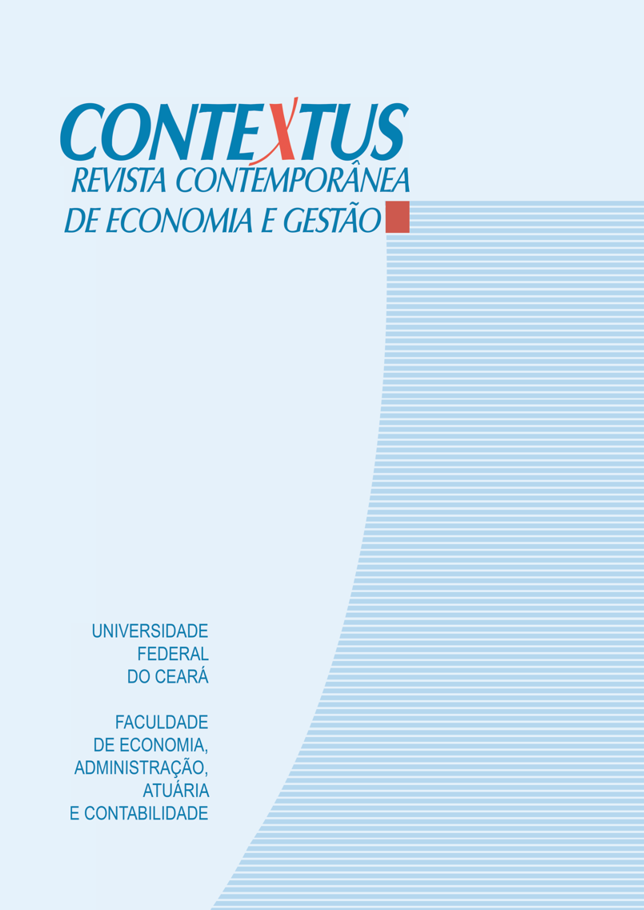Gerenciamento de tons das divulgações voluntárias nos press releases das companhias abertas brasileiras
DOI:
https://doi.org/10.19094/contextus.2020.43366Palavras-chave:
gerenciamento de tons, gerenciamento de resultados, divulgação voluntária, análise textual, press releasesResumo
Este artigo objetiva verificar se companhias abertas brasileiras manipulam informações qualitativas mediante gerenciamento de tons. Foram selecionadas 43 empresas pertencentes ao Ibovespa da Brasil, Bolsa e Balcão (B3), com dados trimestrais entre 2017 e 2018. Os dados referentes à tonalidade positiva foram formatados mediante classificação de palavras de Loughran e McDonald (2011), retiradas dos press releases divulgados voluntariamente pelas companhias e analisados pelo software Atlas.ti8. O índice foi regredido contra os accruals discricionários obtidos em dois modelos de gerenciamento de resultados. Os resultados apontam para relação negativa e significativa entre o gerenciamento contábil e a tonalidade positiva dos relatórios, ou seja, companhias com maior tom positivo gerenciam menos resultados. Estes achados apresentam informações relevantes por evidenciar a qualidade dos textos contidos nos relatórios das companhias.
Downloads
Referências
Beyer, A., Cohen, D. A., Lys, T. Z., & Walther, B. R. (2010). The financial reporting environment: Review of the recent literature. Journal of Accounting and Economics, 50(2-3), 296-343. https://doi.org/10.1016/j.jacceco.2010.10.003
Black, R., & Nakao, S. H. (2017). Heterogeneidade na qualidade do lucro contábil entre diferentes classes de empresas com a adoção de IFRS: evidências do Brasil. Revista Contabilidade & Finanças, 28(73), 113-131. https://doi.org/10.1590/1808-057x201702750
Davis, A. K., Piger, J. M., & Sedor, L. M. (2012). Beyond the numbers: Measuring the information content of earnings press release language. Contemporary Accounting Research, 29(3), 845-868. https://doi.org/10.1111/j.1911-3846.2011.01130.x
Dechow, P. M., & Dichev, I. D. (2002). The quality of accruals and earnings: The role of accrual estimation errors. The Accounting Review, 77(s-1), 35-59. https://doi.org/10.2308/accr.2002.77.s-1.35
Dechow, P. M., Sloan, R. G., & Sweeney, A. P. (1995). Detecting earnings management. The Accounting Review, 70(2), 193-225. https://www.jstor.org/stable/248303
Feldman, R., Govindaraj, S., Livnat, J., & Segal, B. (2010). Management’s tone change, post earnings announcement drift and accruals. Review of Accounting Studies, 15(4), 915-953. https://doi.org/10.1007/s11142-009-9111-x
Giroux, G. (2004). Detecting earnings management. New Jersey: John Wiley & Sons Incorporated.
Gray, S. J., Meek, G. K., & Roberts, C. B. (1995). International capital market pressures and voluntary annual report disclosures by US and UK multinationals. Journal of International Financial Management & Accounting, 6(1), 43-68. https://doi.org/10.1111/j.1467-646X.1995.tb00049.x
Hales, J., Kuang, X. I., & Venkataraman, S. (2011). Who believes the hype? An experimental examination of how language affects investor judgments. Journal of Accounting Research, 49(1), 223-255. https://doi.org/10.1111/j.1475-679X.2010.00394.x
Healy, P. M., & Wahlen, J. M. (1999). A review of the earnings management literature and its implications for standard setting. Accounting Horizons, 13(4), 365-383. https://doi.org/10.2308/acch.1999.13.4.365
Huang, X., Teoh, S. H., & Zhang, Y. (2013). Tone management. The Accounting Review, 89(3), 1083-1113. https://doi.org/10.2308/accr-50684
Kang, S. H., & Sivaramakrishnan, K. (1995). Issues in testing earnings management and an instrumental variable approach. Journal of Accounting Research, 353-367. https://doi.org/10.2307/2491492
Kothari, S. P., Leone, A. J., & Wasley, C. E. (2005). Performance matched discretionary accrual measures. Journal of Accounting and Economics, 39(1), 163-197. https://doi.org/10.1016/j.jacceco.2004.11.002
Kruglanski, A. W., & Thompson, E. P. (1999). Persuasion by a single route: A view from the unimodel. Psychological Inquiry, 10(2), 83-109. https://doi.org/10.1207/S15327965PL100201
Loughran, T., & McDonald, B. (2011). When is a liability not a liability? Textual analysis, dictionaries, and 10‐Ks. The Journal of Finance, 66(1), 35-65. https://doi.org/10.1111/j.1540-6261.2010.01625.x
Oliveira, H. M. S., Lopes, C. M. F. P., & Cunha, C. A. S. (2008). A transparência da informação por parte dos emitentes. Revista Universo Contábil, 4(2), 93-104. https://doi.org/10.4270/ruc.20084
Paulo, E. (2007). Manipulação das Informações Contábeis: Uma Análise Teórica e Empírica Sobre os Modelos Operacionais de Detecção de Gerenciamento de Resultados. (Tese de Doutorado em Ciências Contábeis). Universidade de São Paulo, São Paulo, SP, Brasil. https://www.teses.usp.br/teses/disponiveis/12/12136/tde-28012008-113439/pt-br.php
Petty, R. E., & Cacioppo, J. T. (1986). The elaboration likelihood model of persuasion. In Communication and Persuasion (pp. 1-24). Springer, New York, NY. https://link.springer.com/chapter/10.1007/978-1-4612-4964-1_1
Popova, T., Georgakopoulos, G., Sotiropoulos, I., & Vasileiou, K. Z. (2013). Mandatory disclosure and its impact on the company value. International Business Research, 6(5), 1-16. https://doi.org/10.5539/ibr.v6n5p1
Sloan, R. G. (1996). Do stock prices fully reflect information in accruals and cash flows about future earnings? The Accounting Review, 71(3), 289-315. https://www.jstor.org/stable/248290
Subramanyam, K. R. (1996). The pricing of discretionary accruals. Journal of accounting and economics, 22(1-3), 249-281. https://doi.org/10.1016/S0165-4101(96)00434-X
Tetlock, P. C., Saar‐Tsechansky, M., & Macskassy, S. (2008). More than words: Quantifying language to measure firms' fundamentals. The Journal of Finance, 63(3), 1437-1467. https://doi.org/10.1111/j.1540-6261.2008.01362.x
Watts, R. L. & Zimmerman, J. L. (1986). Positive Accounting Theory. New Jersey: Prentice Hall.
Watts, R. L., & Zimmerman, J. L. (1990). Positive accounting theory: a ten year perspective. Accounting Review, 65(1), 131-156. https://www.jstor.org/stable/247880
Publicado
Como Citar
Edição
Seção
Licença
Os autores, no ato da submissão, aceitam a declaração abaixo:
Nós autores mantemos sobre nosso artigo publicado os direitos autorais e concedemos à revista Contextus o direito de primeira publicação, com uma licença Creative Commons na modalidade Atribuição – Não Comercial 4.0 Internacional, a qual permite o compartilhamento com reconhecimento da autoria e da publicação inicial nesta revista.
Temos ciência de estarmos autorizados a assumir contratos adicionais separadamente, para distribuição não exclusiva da versão do trabalho publicada nesta revista (ex.: publicar em repositório institucional ou como capítulo de livro), também com reconhecimento tanto da autoria, quanto da publicação inicial neste periódico.
Atestamos que o artigo é original ou inédito, não foi publicado, até esta data, em nenhum periódico brasileiro ou estrangeiro, quer em português, quer em versão em outra língua, nem está encaminhado para publicação simultânea em outras revistas.
Sabemos que o plágio não é tolerado pela revista Contextus e asseguramos que o artigo apresenta as fontes de trechos de obras citadas, incluindo os de qualquer trabalho prévio produzido e publicado pelos próprios autores.









3.png)


1.jpg)



1.jpg)


1.jpg)






.jpg)



1.jpg)

1.jpg)


1.jpg)

1.jpg)
1.jpg)
2.png)




1.jpg)
2.jpg)

1.jpg)





1.jpg)


1.jpg)
1.jpg)
